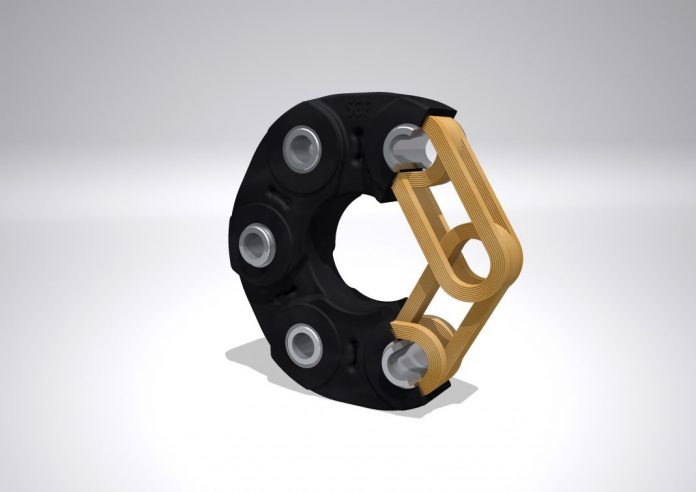The reduction of noise and vibrations is important when designing a vehicle. This is intended to increase driving comfort and to reduce the forces acting upon the vehicle components. This also includes the drive train.
Vehicles equipped with rear-wheel or four-wheel drive transmit power from the engine via the transmission to the axles using a propshaft. During operation, their angle relative to the transmission and final drive changes due to the unevenness in the road surface which is absorbed by the vehicle suspension system.
If there were no joints at each end of the propshaft, the shaft would bend and break. One solution is the flexible propshaft clutch (also known as universal joint, rag joint, Giubo, or Doughnut coupling). It is a reinforced, flexible rubber disc that connects the gear output flange to the propshaft input flange. Some versions, due to high torsional requirements, have an additional flexible disc attached to the propshaft output flange which is connected to the final drive flange.
Successfully Absorbs Vibrations
The flexible disc absorbs the vibrations and the load changes of the drive train. All of the motor’s torque must be transmitted through the flexible disc before it reaches the wheels via the drive shaft and differential axles. The design of the flexible disc absorbs the shock and load forces, prevents disturbances in the drive train, and prevents harmful angular misalignment. This reduces noise and vibrations from the drive train.
The flexible disc is heavily stressed, therefore it should be checked at regular maintenance intervals. If wear occurs on the flexible disc, this can lead to various problems, including vibrations and/or shocks in the drive train which can increase during acceleration. During the inspection, the flexible discs should be checked for cracks, missing parts, or distortions. Any cracking or bulging indicates a defective flexible disc and replacement should follow.
How the Exchange Works
When replacing a flexible disc, especially a disc that has been operated to the destruction limit, inspect the guide bush of the propshaft centering, the fitting surfaces, the pin bores, and the bolt threads. If any parts are worn, the shaft may still vibrate after the installation of a new flexible disc.
When replacing a defective flexible disc, the design and construction of the replacement part must be observed. A flexible disc is made of fabric-reinforced rubber with metal inserts for the connecting bolts which pass through both sides of the counter flanges to create a very strong, yet flexible connection.
The properties of this component must provide good damping of torque peaks in the drive train and must compensate for radial, axial, and angular misalignment. The advantages are the rigidity, the ability to compensate in all directions, and the resistance to torsional loads ensuring a long service life.
When replacing the flexible disc(s), pay attention to the marked alignment in order to ensure that the disc functions correctly. It is also recommended to replace the fixing screws as suggested by the manufacturer. Make sure that all screws are correctly tightened in accordance with the vehicle manufacturer’s specifications.
All febi flexible discs are manufactured by the OE supplier SGF, the global market leader in the automotive sector. They guarantee maximum reliability, smooth running, and a first-class fit.




